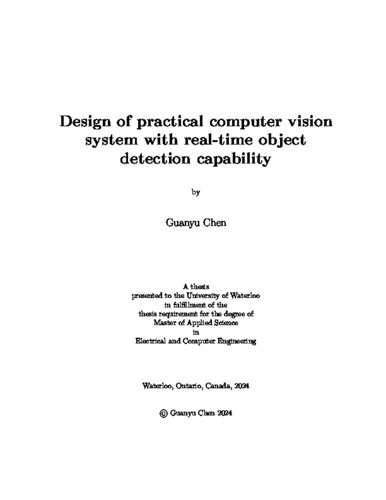| dc.contributor.author | chen, guanyu | |
| dc.date.accessioned | 2024-03-07 15:37:15 (GMT) | |
| dc.date.available | 2024-03-07 15:37:15 (GMT) | |
| dc.date.issued | 2024-03-07 | |
| dc.date.submitted | 2024-03-03 | |
| dc.identifier.uri | http://hdl.handle.net/10012/20385 | |
| dc.description.abstract | Computer vision nowadays relies heavily on machine learning techniques to interpret
useful information from images or videos. Object detection is one such computer vision
technique for identifying and locating objects in images. This type of application is of
great interest for its potential use in various fields including product inspection, analysis,
security, etc.
As another important technique in computer vision, object recognition for identifying
objects in images has been accomplished earlier. Classic models including LeNet and
VGG16 have already adopt CNN-like architectures. In comparison, an object detection
model would not only identify objects, but also label each detected object with a bounding
box. Provided ground truth labels about both object class and bounding box coordinates,
object detection models can be trained regularly for making both predictions. Certain
families of object detection models are listed as follows: In R-CNN, the Region Proposal
Network (RPN) produces region proposals, corresponding to rectangular regions in the
image in which targeting object is possibly present. YOLO divides the input image into
grids and predicts the bounding box and class confidence simultaneously for each grid.
SSD is a similar model to YOLO but has better accuracy by using features at different
scales. As a result of improved hardware performance and innovative network architecture
in recent years, real-time object detection has become possible with both satisfying speed
and accuracy.
The goal of this thesis is to implement a real-time object detection system based on
some of the already published models, with the Proposal Connection Network (PCN)
discussed in more detail. PCN in simple terms is a two-stage, anchor-free object detection
model with unique advantages. Following the demonstration of system design and setup
are training and experimental processes, focusing primarily on performance analysis and
comparison among models. | en |
| dc.language.iso | en | en |
| dc.publisher | University of Waterloo | en |
| dc.title | Design of practical computer vision system with real-time object detection capability | en |
| dc.type | Master Thesis | en |
| dc.pending | false | |
| uws-etd.degree.department | Electrical and Computer Engineering | en |
| uws-etd.degree.discipline | Electrical and Computer Engineering | en |
| uws-etd.degree.grantor | University of Waterloo | en |
| uws-etd.degree | Master of Applied Science | en |
| uws-etd.embargo.terms | 0 | en |
| uws.contributor.advisor | ho, pinhan | |
| uws.contributor.affiliation1 | Faculty of Engineering | en |
| uws.published.city | Waterloo | en |
| uws.published.country | Canada | en |
| uws.published.province | Ontario | en |
| uws.typeOfResource | Text | en |
| uws.peerReviewStatus | Unreviewed | en |
| uws.scholarLevel | Graduate | en |

